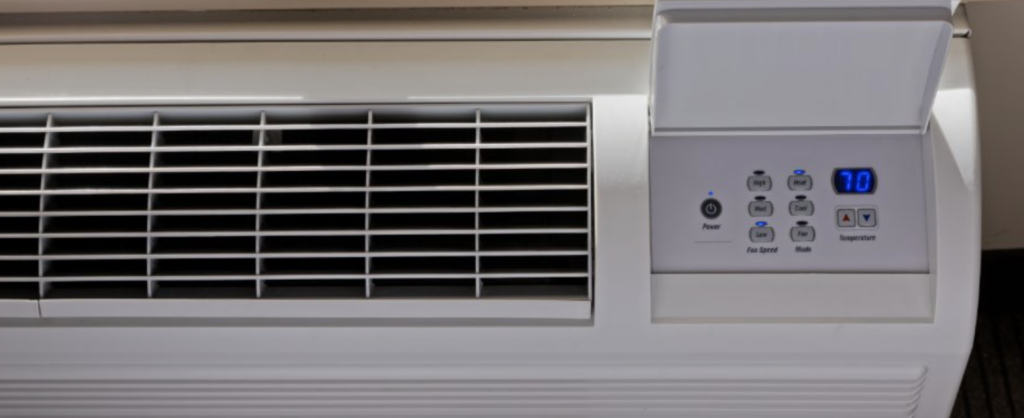Common Problems with PTAC Units explained.
Common Problems with PTAC Units can be stressful but worry no more as this post will take you through solving the problem.
While these units offer several benefits, they also come with their fair share of common problems that can disrupt comfort and efficiency. In this introduction, we will explore some of these issues.
Related post>>>>>Goodman Air Conditioner Problems.
One of the most prevalent problems with PTAC units is inadequate cooling or heating. This can be caused by various factors, including dirty filters, refrigerant leaks, or a malfunctioning thermostat. Inefficient temperature control can lead to discomfort and increased energy consumption.

Another common issue is noisy operation. PTAC units can produce distracting noises, from rattling and buzzing to clanging and hissing.
These noises can be disruptive, especially in quiet environments such as hotel rooms or bedrooms.
Maintenance challenges are also frequent. PTAC units require regular cleaning and servicing to function optimally, and neglecting maintenance can lead to reduced efficiency and costly repairs down the line.
Lastly, poor ventilation and air quality can be a problem. PTAC units may not provide adequate fresh air exchange, potentially leading to stale indoor air and discomfort.
In this discussion, we will delve deeper into these common problems with PTAC units, their causes, and potential solutions, helping you better understand and address these issues for a more comfortable and efficient indoor environment.
Common Problems with PTAC Units and how to Fix Them.
1.Water leaks.
Water leaks are undeniably one of the most prevalent and concerning issues encountered by PTAC unit owners. These leaks can lead to various problems, including structural damage, mold growth, and even electrical hazards.
As our first Common Problems with PTAC Units, understanding the signs, causes, and solutions for water leaks in PTAC units is crucial to maintain a safe and comfortable environment.
Signs of Water Leaks:
Water Dripping from the Unit: The most apparent sign of a water leak is moisture dripping from the PTAC unit into the room it serves.
Causes of Water Leaks
- Long Periods of Inactivity: When PTAC units are not used for extended periods, moisture can accumulate inside them due to the absence of temperature regulation, leading to condensation and leaks.
- Irregular Cleaning or Improper Maintenance: Neglecting regular cleaning and maintenance can result in clogged drain lines and evaporator coils, causing water to overflow and leak into the room.
- Improper Installation: An incorrectly installed PTAC unit, especially one without the proper outside tilt, can hinder proper drainage, making it more prone to leaks.
Solutions to Prevent Water Leaks.
- Regular Operation: To prevent moisture buildup, it’s essential to run the PTAC unit periodically, especially in situations like hospitality accommodations where rooms may remain unoccupied for extended periods.
- Use of Dehumidifiers: In regions with extreme cold or high humidity, consider using dehumidifiers in conjunction with the PTAC unit to minimize moisture accumulation.
- Annual Servicing: Schedule annual maintenance by a qualified technician to ensure your PTAC unit is operating correctly. This can help identify and address issues that might lead to leaks before they become serious problems.
- Proper Installation: During installation, ensure that the PTAC unit is positioned with a slight outside tilt to facilitate proper drainage of condensate water away from the interior components.
2.PTAC Is Struggling to Work.
When your PTAC unit struggles to maintain the desired temperature, whether it’s not cooling or heating effectively, it can be both frustrating and uncomfortable.
This issue is often linked to reduced airflow caused by clogged air filters or blockages in the unit’s intake and vents.
Identifying the signs, root causes, and solutions for a PTAC unit that’s struggling to work is essential for restoring its efficiency.
Also read>>>>Air Conditioner Not Blowing Cold Air.
Signs of a PTAC Unit Struggling to Work:
- Inadequate Cooling or Heating: The primary indicator of a struggling PTAC unit is its inability to provide the desired temperature, resulting in air that isn’t cold or hot enough.
- Abnormal Noises During Operation: Unusual sounds, such as rattling or clanking, may accompany a PTAC unit that’s struggling, signaling underlying issues.
Causes of a PTAC Unit Struggling to Work.
- Dirty Air Filter: A clogged air filter restricts the flow of air through the unit, reducing its cooling or heating capacity.
- Blockages in Air Intakes and Vents: Dust, debris, pet dander, or even household items can obstruct the PTAC unit’s air intakes and vents, hindering proper airflow.
Solutions to Address a PTAC Unit Struggling to Work.
- Regular Air Filter Cleaning: To maintain optimal performance, clean the air filter regularly. The frequency of cleaning should increase with the unit’s usage.
- Clear Obstructions: Ensure that the PTAC unit is not blocked by household items, dropped objects, or furniture, as these can disrupt airflow.
- Check Outside Obstructions: Examine the exterior of the unit to ensure there are no obstructions caused by foliage, environmental debris, or other factors that might hinder proper airflow.
3.Ice Formation.
Ice formation on a PTAC unit is a concerning issue that can occur, particularly in regions with extreme cold climates or due to underlying problems with the unit.
Recognizing the signs, understanding the potential causes, and knowing how to address ice buildup is crucial to prevent further damage and ensure the efficient operation of your PTAC.
Signs of Ice Formation.
Ice Buildup on the Outside of the Unit: Visible ice accumulation on the exterior components of the PTAC unit is a clear indicator of the problem.
Causes of Ice Formation.
- Damaged Thermostat: A malfunctioning thermostat can cause the PTAC unit to operate inappropriately, leading to temperature fluctuations and ice formation.
- Fan Issues: Problems with the fan, such as malfunctioning or blocked blades, can disrupt the unit’s airflow and contribute to ice buildup.
- Extremely Cold Temperatures: In regions where temperatures plummet to extreme lows, PTAC units are more susceptible to ice formation, especially when not equipped with proper temperature controls or insulation.
Solutions to Address Ice Formation
- Unplug and Seek Professional Help: If you notice ice buildup on your PTAC unit, immediately unplug it to prevent further damage. Contact a qualified service technician who can diagnose the issue and perform the necessary repairs.
- Avoid Using the PTAC: It’s crucial not to use the PTAC until the root cause of the ice formation has been identified and rectified. Operating the unit under these conditions can exacerbate the problem and potentially lead to more extensive damage.
Also read>>>>>AC Fan not Spinning.
4.The PTAC Is Emitting Strange Sounds.
Unusual sounds emanating from a PTAC unit during its operation can be disconcerting and often serve as indicators of underlying issues.
Recognizing the type of sound and understanding its potential causes is essential to address the problem effectively and maintain the functionality of your PTAC.
Signs of Strange Sounds.
- Humming: A humming sound may suggest a broken fan blade within the PTAC unit.
- Wheezing: Wheezing noises typically indicate that the unit is struggling, often due to dirty filters or obstructed air intakes.
- Vibrations: Vibrations may result from loose or broken mounting brackets, causing the unit to shake during operation.
- Crackling: A crackling sound can be associated with electrical shorts within the PTAC unit.
Solutions to Address Strange Sounds.
- Unplug and Inspect: If you notice unusual sounds emanating from your PTAC unit, the first step is to unplug it immediately. Inspect the exterior of the unit for loose mounting brackets or any visible issues.
- Check the Fan: Examine the fan for damage or missing blades, as this can often be the source of humming sounds. Damaged fans should be replaced promptly.
- Inspect Filters and Intakes: Ensure that the air filters are clean and the intakes are not obstructed. Wheezing sounds can often be resolved by cleaning or replacing dirty filters and clearing any blockages.
- Discontinue Use and Seek Service: If the strange sounds persist despite your initial checks, it’s advisable to discontinue using the PTAC unit to prevent further damage or safety hazards. Contact a professional service technician to diagnose and repair the issue.
Also read>>>>Air Conditioner Keeps Turning On & Off.
5.The PTAC Won’t Turn on/Shuts off.
When your PTAC unit refuses to turn on or shuts off unexpectedly, it can be a worrisome sign of underlying issues.
Understanding the potential causes and taking appropriate steps to address the problem is crucial to ensure the continued functionality of your PTAC.
Possible Causes for PTAC Not Turning On or Shutting Off.
- Tripped Fuse: A tripped fuse or circuit breaker can interrupt the power supply to the PTAC, causing it to shut off.
- Water Damage: Water infiltration inside the unit, whether due to leaks or condensation, can damage electronic components and trigger safety mechanisms that shut down the unit.
- Damage to Wiring or Electronic Components: Wiring issues or damaged electronic components can disrupt the unit’s operation, leading to failure to turn on or abrupt shutdowns.
Solutions to Address PTAC Not Turning On or Shutting Off.
- Clean the Vents: Blocked or clogged vents can obstruct proper airflow, leading to overheating and tripping the circuit breaker. Regularly cleaning the vents can help prevent this issue.
- Inspect for Water or Ice Formation: Check the interior of the PTAC for any signs of water or ice formation, which could indicate leaks or condensation issues. Addressing these problems promptly is essential.
- Unplug and Seek Professional Help: If your PTAC unit still refuses to turn on or continues to shut off unexpectedly, unplug it immediately to prevent further damage. Contact an HVAC technician with expertise in PTAC units to diagnose and rectify the issue.
Frequently Asked Questions (FAQs)
Why is my PTAC unit leaking water into the room?
A: Water leaks can result from prolonged inactivity, irregular cleaning, or improper installation. To address this, run the PTAC regularly, ensure proper maintenance, and check for proper installation with a slight outside tilt.
My PTAC unit isn’t cooling or heating effectively, and it’s making strange sounds. What’s wrong?
A: Inadequate temperature control and unusual sounds can be due to clogged air filters, blocked intakes, or damaged components. Regularly clean the air filter, clear obstructions, and inspect the unit for damage or missing fan blades.
I noticed ice formation on my PTAC unit. What should I do?
A: Ice formation can occur due to a damaged thermostat, fan issues, or extremely cold temperatures. If you see ice buildup, unplug the unit, and contact a service technician for diagnosis and repair.
My PTAC unit emits strange sounds during operation. What could be the cause?
A: Unusual sounds can indicate problems such as broken fan blades, dirty filters, loose mounting brackets, or electrical shorts. First, unplug the unit, then inspect and troubleshoot based on the specific sound you hear.
My PTAC unit won’t turn on or shuts off unexpectedly. What might be the issue?
A: Possible causes include a tripped fuse, water damage, or damaged wiring or components. Clean the vents regularly, check for water or ice formation, and if the problem persists, unplug the unit and call an HVAC technician.
How can I prevent common problems with my PTAC unit?
A: Regular maintenance is key to prevention. Clean the air filter, ensure unobstructed airflow, and schedule annual servicing by a professional technician. Additionally, consider using a dehumidifier in extremely cold or humid environments.
Where can I find reliable PTAC units and expert advice for troubleshooting issues?
A: At Total Home Supply, we offer a wide selection of PTAC units from top brands, backed by industry-leading warranties.
Our experienced HVAC professionals can provide expert advice and assist you in resolving any PTAC-related problems you encounter.
Also read>>>>Air Conditioner Leaking Freon.
Conclusion.
In conclusion, common problems with PTAC units can range from water leaks and temperature control issues to unusual sounds and ice formation.
These issues, though frequent, are manageable with proper maintenance and prompt attention.
Regular cleaning of air filters, inspecting for obstructions, and scheduling annual servicing by professionals can go a long way in preventing and addressing these concerns.
Safety precautions such as unplugging the unit when issues arise are essential.
Total Home Supply offers a wide range of reliable PTAC units and expert advice to assist users in resolving problems and ensuring their PTAC units operate efficiently, enhancing indoor comfort and longevity.
Watch More:















